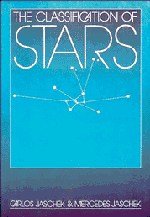2 - Spectral classification
Published online by Cambridge University Press: 04 April 2011
Summary
This chapter describes spectral classification in general, without referring to a particular classification system.
We start by discussing certain specifications of the spectroscopic material. Then we describe the features of the spectra and the factors which may affect them. Next we consider the process of classification itself and finally we deal with certain aids to classification.
The material of spectral classification
A spectrum is the display of stellar radiation as a function of wavelength. The names of the different wavelength regions are given in table 2.1. Astronomers also talk of the ‘ultraviolet spectrum’ of a star; this is a short way of speaking of the ‘ultraviolet region of the spectrum’ of the star.
Once a spectrum has been obtained, certain details about it must be provided. In first place, what and how it was observed must be specified. Among the most important specifications is the wavelength range covered. Note that one should specify what the (usable) spectrum region is, rather than state that ‘103aO plates used’ because in a few years this will not be understandable. Next the plate factor (D) should be specified, which is the number of angstroms of the spectrum entering 1 mm length of receiver. Much confusion originates here because astronomers call D the ‘dispersion’, whereas opticians call it (correctly) the ‘reciprocal dispersion’. A small plate factor D implies highly dispersed spectra (i.e. large scale), and a large value of D, low dispersion spectra.
- Type
- Chapter
- Information
- The Classification of Stars , pp. 8 - 30Publisher: Cambridge University PressPrint publication year: 1987



